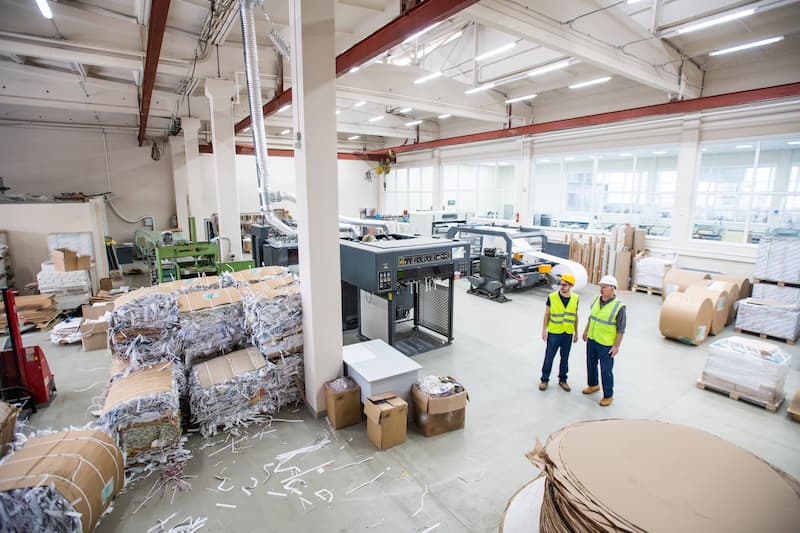Companies are increasingly recognizing the need to transition towards a more efficient, sustainable work environment. One of the most effective ways to do this is by leveraging systems that facilitate digital workflows. By reducing reliance on physical processes, businesses not only help the environment but also streamline their operations, increase efficiency, and achieve significant cost savings. In this blog post you’ll learn about how to reduce paper waste with effective document management.
Understanding the Impact of Paper Waste on the Office Environment
The Environmental Impact of Paper Waste
Waste continues to be a significant environmental issue for businesses. The excessive use of physical resources contributes to deforestation, increased energy consumption in production, and more waste filling landfills. Reducing waste in the office environment is a simple way for businesses to lessen their environmental footprint and contribute to sustainability efforts. By transitioning to digital solutions, companies can significantly lower their environmental impact.
Reducing waste also reduces the demand for physical products, which, in turn, lowers greenhouse gas emissions related to production and transportation. It is essential for companies aiming for sustainability to embrace solutions that eliminate the need for unnecessary usage in the workplace.
Common Sources of Paper Waste in the Workplace
Despite the increasing use of digital tools, many businesses still rely heavily on physical resources for everyday operations. From workflows and project management to sharing and storing information, businesses often consume much more than necessary. In many cases, waste in your office is the result of inefficient processes that can easily be digitized.
For example, the overuse of physical copies and printing information that is rarely referenced contributes to unnecessary waste. Additionally, poor control over information can result in multiple versions of the same file being printed and filed. By addressing these inefficiencies and implementing digital systems, businesses can promote a more sustainable workflow.
Document Management Systems: The Key to Reducing Paper Usage
What is a Document Management System?
A document management system is a software solution designed to digitize, store, and manage documents electronically. Instead of relying on paper files, businesses can use these systems to store documents in cloud storage, improving accessibility and reducing the need for physical storage. Document management systems also allow for better version control, ensuring that the most recent version of a document is always accessible, eliminating the need for printing and filing multiple versions.
By transitioning to a paperless office and adopting a document management system, businesses can reduce paper usage significantly. A document management solution also supports sustainability efforts by digitizing business processes, reducing the need for physical paper, and ensuring that sensitive information is securely stored and managed.
Digital Document Management: Streamlining Office Workflows
One of the main benefits of digital document management is the ability to streamline workflows. Digital systems make it easier to access, share, and collaborate on documents without relying on physical paper. Document scanning allows businesses to convert paper documents into digital formats, which can then be stored electronically and retrieved instantly.
Digital document management systems also reduce the time employees spend searching for paper documents, as files can be indexed and categorized for easy retrieval. This not only enhances efficiency but also improves overall productivity by eliminating bottlenecks caused by paper-based workflows. For businesses looking to reduce paper waste, streamlining processes with a digital document management system is an effective way to improve both sustainability and efficiency.
Benefits of Going Paperless and Embracing Digital Solutions
Reducing Paper Usage and Improving Sustainability
Going paperless offers businesses numerous sustainability benefits, especially in reducing their environmental impact. A paperless office means fewer trees are cut down for paper production, and businesses can reduce their paper consumption significantly. Additionally, using digital solutions eliminates the need for paper products, thus reducing the energy and water used in paper manufacturing and recycling processes.
Reducing paper usage in the office also means fewer physical storage requirements, leading to a decrease in physical space consumption and overhead costs. The long-term benefits of digitizing documents and reducing reliance on paper contribute to a more sustainable and efficient workplace, and many businesses are making sustainability a core component of their operations.
Cost Savings and Productivity Benefits of a Paperless Office
In addition to environmental benefits, going paperless leads to cost savings for businesses. Reducing the need for paper products, ink, and printer maintenance can save businesses a significant amount of money over time. Physical storage of paper documents also incurs costs, such as filing cabinets, office space, and security measures to protect sensitive files. By storing documents electronically, businesses can reduce these overhead costs and redirect their resources towards other critical areas.
The productivity benefits of a paperless office are also substantial. Digital document management systems allow employees to access documents from any location with cloud storage, improving flexibility and collaboration. Additionally, digitizing workflows helps reduce human error, ensuring that documents are always up-to-date and easy to access. This enhances the overall operational efficiency of the business.
Transitioning to a Paperless Office: Steps to Get Started
Step 1: Assess Your Current Paper Usage and Identify Areas for Reduction
Before transitioning to a paperless office, businesses should assess their current paper usage and identify areas where they can reduce waste. This audit can help pinpoint the most paper-intensive processes and highlight opportunities to digitize workflows. Whether it’s scanning paper documents, implementing electronic signatures, or reducing reliance on physical files, identifying these areas is the first step in reducing paper waste.
By evaluating the office’s reliance on physical paper and the inefficiencies that arise from it, businesses can make informed decisions about the document management system they need to implement. This assessment also helps businesses set realistic goals for reducing paper consumption and tracking progress over time.
Step 2: Choose the Right Document Management Solution for Your Business
Once businesses have assessed their paper usage, the next step is choosing the right document management solution. Different digital document management systems offer a range of features, including cloud storage, document scanning, access controls, and audit trails. Choosing the right system depends on the business’s size, industry, and specific workflow needs.
A good document management solution will allow businesses to store documents electronically, manage digital workflows, and ensure secure document sharing. These systems also help reduce the risk of data breaches by providing enhanced security features, such as encryption and secure document access. By selecting the right document management system, businesses can ensure a smooth transition to a paperless office.
H3: Step 3: Digitize Paper Documents and Convert Them to Digital Formats
Once a document management system has been implemented, businesses should begin digitizing their existing paper documents. Document scanning is a crucial step in this process, as it allows businesses to convert physical copies into digital formats that can be stored electronically. This reduces the need for physical storage space and ensures that documents are easily accessible from any device.
By digitizing paper files, businesses can also enhance document security by implementing version control, access controls, and audit trails. This ensures that only authorized personnel can access sensitive information, reducing the risk of unauthorized access or data breaches.
How to Reduce Paper Waste in Your Office: Practical Tips
Implement Double-Sided Printing to Reduce Paper Usage
One simple way to reduce paper waste in your office is by implementing double-sided printing policies. Double-sided printing cuts paper usage in half, reducing the amount of paper consumed and lowering the costs associated with paper purchasing. Encouraging employees to use double-sided printing whenever possible is an easy yet effective way to make a significant impact on reducing paper waste.
Encourage the Use of Recycling Bins and Paper Waste Reduction Initiatives
Recycling bins should be easily accessible throughout the office to encourage proper disposal of paper waste. By recycling paper products, businesses can further reduce their environmental footprint. Additionally, businesses should promote paper waste reduction initiatives, such as limiting unnecessary printing, reusing scrap paper, and transitioning to digital workflows for internal communications.
Foster a Culture of Sustainability and Reduced Reliance on Physical Paper
Creating a culture of sustainability in the office is essential for reducing paper waste in the long term. Encouraging employees to embrace digital solutions, participate in recycling programs, and minimize the reliance on physical paper files can significantly reduce paper usage. By making sustainability a company-wide goal, businesses can foster a workplace culture that prioritizes environmental responsibility and efficient resource management.
7 Steps to Successfully Transitioning to a Paperless Office
Step 1: Conduct a Paper Waste Audit
Conducting an audit of your office paper usage is the first step towards reducing waste and identifying areas for improvement. By understanding where the most waste paper is generated, businesses can develop strategies to cut back and implement cloud-based document management alternatives. This process also helps in identifying areas where businesses can reduce reliance on unnecessary paper and transition towards a paperless environment. The audit should also include identifying opportunities for double-sided printing, which significantly reduces paper consumption.
Step 2: Implement a Document Management System
A document management system is critical for transitioning to a paperless office. These systems provide the ability to digitize documents, store them electronically, and streamline workflows. Implementing a cloud-based document management system enhances operational efficiency by making it easier to access, share, and manage documents without the need for physical files. A paperless system also contributes to the reduction of waste paper and unnecessary paper usage, helping businesses embrace a paperless office.
Step 3: Encourage Digital Document Sharing
Instead of relying on pen and paper or printing and distributing physical copies of documents, businesses should encourage digital document sharing. Using cloud-based systems or email for document distribution not only reduces waste paper but also enhances efficiency and makes collaboration more effective. The shift to digital sharing eliminates the need for physical storage and manual handling, offering many benefits for businesses, including reduced paper consumption and improved operational efficiency.
Step 4: Digitize Your Document Storage
Storing documents electronically rather than physically eliminates the need for paper-based filing systems. This not only reduces waste but also saves office space and improves document security. A paperless system also contributes to a more organized workflow, as digital documents are easier to search, access, and manage. Embracing a paperless environment through digitization also contributes to long-term sustainability efforts.
Step 5: Promote the Benefits of Going Paperless
Educating employees on the many benefits of embracing a paperless office, including cost savings, improved productivity, and environmental sustainability, can help foster buy-in for paper reduction initiatives. A paperless office offers significant operational efficiency by streamlining processes, eliminating unnecessary paper usage, and reducing reliance on physical resources. It is important to highlight how a paperless system can enhance efficiency, reduce waste, and promote a sustainable office culture.
Step 6: Track Your Progress in Reducing Paper Waste
Monitoring office paper usage and evaluating the success of paper reduction strategies allows businesses to adjust their approaches as needed and celebrate milestones in their journey toward a paperless office. Tracking progress ensures continuous improvement in waste reduction, and the results can be further enhanced by encouraging the use of recycling bins to properly dispose of any remaining waste paper.
Step 7: Embrace Ongoing Digital Solutions to Reduce Paper Usage
To maintain a paperless office, businesses should continuously adopt new digital solutions that further reduce their reliance on physical paper. This could include embracing cloud storage, digital signatures, and mobile apps for document management. These solutions enhance operational efficiency and ensure businesses stay committed to their paperless transition. A paperless office also contributes to overall sustainability efforts by reducing the need for physical resources and encouraging the adoption of digital workflows.
Reducing paper waste with document management systems is an essential step toward creating a more sustainable, efficient, and productive workplace. By transitioning to a paperless office, businesses can reduce their reliance on physical paper, lower operational costs, and minimize their environmental footprint. Implementing digital document management solutions and promoting a culture of sustainability can help businesses achieve their goals of reducing waste and improving efficiency. As companies continue to embrace digital solutions, the benefits of going paperless will become even more apparent, leading to a future where businesses can operate with minimal paper waste and maximum productivity.









